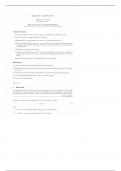Lecture notes
SMA 2101: CALCULUS I c Francis O. Ochieng francokech@gmail.com Department of Pure and Applied Mathematics Jomo Kenyatta University of Agriculture and Technology
- Module
- Institution
SMA 2101: CALCULUS I c Francis O. Ochieng Department of Pure and Applied Mathematics Jomo Kenyatta University of Agriculture and Technology Course content • Functions: definition, domain, range, codomain, composition (or composite), inverse. • Limits, continuity and differentiability of...
[Show more]



